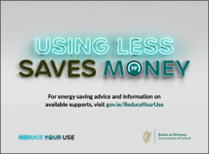Case Study Overview
In April 2022, the Irish government launched an energy security framework to in response to the energy crisis, including a national campaign to deliver information and advice to the public. The “Reduce Your Use” campaign was launched in spring, and updated after the government budget was announced, with messaging that included details of energy bills and cost of living support measures.
Design

Target audience: The campaign initially targeted all Irish citizens but introduced a secondary message for at–risk populations, including renters, single parents, people with disabilities and the elderly, as well as a campaign strand targeted specifically at businesses. This change of focus occurred in response to the results of a consumer tracker. A key purpose of the campaign was to ensure that the government was actively listening to the public; understanding and responding to their needs and concerns to determine the most useful advice and information in relation to the evolving energy situation. A nationally representative group was surveyed on a fortnightly basis from October 2022 to March 2023 to test response to messaging and consumer sentiment. Based on the results, the government identified particularly vulnerable cohorts and readjusted the campaign to specifically support households in (or at–risk of) energy poverty.
Objectives and message: The primary objective of the campaign in the initial stages was to reduce energy use across all sectors to protect the national grid. As energy costs and general cost of living increases began to impact on the public, focus shifted to the financial assistance and supports available for those struggling with energy bills. The surveys carried out were a

lso used to inform the messaging used. People indicated seeking practical advice on how to reduce their energy use, that they were worried about energy costs, and needed reassurance about support measures. A balanced message focused on reducing bills and staying warm and well was therefore developed. The campaign strategy was informed by best practices in crisis communications, advice from a strategic creative agency, and research and analysis from behavioural insights supported by the Department of the Environment, Climate and Communications.
Resources: A team of three worked on energy communications in the Department, including the development of the “Reduce Your Use” campaign. A creative agency was hired to develop the approach and messaging, while a media agency created an effective media plan and partnerships. An Energy Security Communications Subgroup was formed to contribute to the development of the campaign, which included transmission and distribution system operators, the Regulator, and other government departments responsible for energy, including the Sustainable Energy Authority of Ireland who support each phase with behaviour change activities.
The most important lesson: Prior to the campaign, there was no relevant energy consumer data or research to refer or to inform the communications. This needed to be instigated. Identifying key target groups and ensuring they received the right message at the right time and at the right place was key. Using targeted messaging helped reach more vulnerable customers directly. It proved important to refresh the message at regular intervals, avoid patronising and directive language, and translate the message to reach all population groups. Testing ads using specific questioning proved to be useful in this regard.
Implementation
Media channels used: The media plan for this phase was developed with the objective of reaching the maximum number of adults possible across Ireland. It consisted of a National door drop, TV, cinema, social, digital, and out of home (OOH) advertising alongside media partnerships. Initially, as the “Reduce Your Use” campaign started out as an information campaign, the visuals were kept simple and informative. As the campaign moved into the winter phase and more channels were added into the mix, it became clear that this approach wouldn’t be as impactful for TV and cinema. The visuals here were chosen to clearly demonstrate the tips and advice that were central to the campaign messaging. It was decided to move away from the main ‘Reduce Your Use’ message, and to focus on the “Using Less Saves Money” and “Stay Warm and Well” slogans as messaging pivoted towards helping those who were struggling.
Recommended measures: The campaign initially focused on heating, appliances, travel and driving for households, and heating, lighting, electricity, and manufacturing for businesses. When the focus of the campaign shifted towards vulnerable households, support measures such as grants were communicated to the target audience.

Stakeholder involvement: The Energy Security Communications sub-group and state agencies were consulted at every stage to inform the campaign, and several non-government organisations, including budgeting advice services and elderly support services, helped to ensure the messaging had impact and reached the target audiences.
The most important lesson: It proved crucial to ensure alignment of messaging through constant collaboration with other stakeholders in the energy space who are running campaigns aimed at energy users. It was challenging to ensure partner bodies, with information helplines people could use, had enough time to manage an increase in calls and enquiries. Recognising that not everyone is starting from the same place in their energy efficiency journey was an important lesson and resulted in the campaign conveying two different messages for separate audiences – e.g. reducing energy use and saving money for those able to do so; and accessing support to stay warm and well for those at risk. Maintaining the same tone in terms of being helpful, informative, encouraging and reassuring without becoming directive, patronising or alarming is useful for future campaign bursts. For example, easy-to-read infographics highlighting the cost of daily appliance usage and avoiding being too general in any recommendations to ensure they can be enacted by most of the public.
Tracking
Impacts: Media partners estimated a reach of 99.9% of all adults; research supported this with ad recall peaking at 85%. Website analytics showed high levels of traffic to the campaign page throughout the campaign and campaign partners also reported significant increases in traffic to their websites and helplines. Research showed people are in favour of government educating people in the energy space; and that the majority found the ads helpful. Research also showed people were mostly in favour of the continuation of the campaign’s tertiary messaging around energy efficiency, climate action, sustainability and decarbonisation. Energy suppliers also welcomed the campaign, and some incorporated it into their own communication.
Outcomes: Metered electricity consumption in the residential sector saw a decrease of 12% in 2022. The campaign brought together all the different agencies and stakeholders involved in the wider energy space and provided a platform for a range of NGOs and others providing frontline information and support.
The most important lesson: It is difficult to measure the direct effect of the campaign on behaviour and energy consumption. Although surveys tracked self-reported behaviour change, measuring household consumption in ‘real time’ was not possible. The rollout of smart meter technology should assist in this regard.
Campaign Summary
| Agency | Department of Environment, Climate and Communications (DECC) Sustainable Energy Authority of Ireland (SEAI) |
| Slogan | Reduce Your Use |
| Website | gov.ie – Reduce your use (www.gov.ie) |
| Contact person | Tom Halpin (tom.halpin@seai.ie) Alison Daly (alison.daly@decc.gov.ie) |


